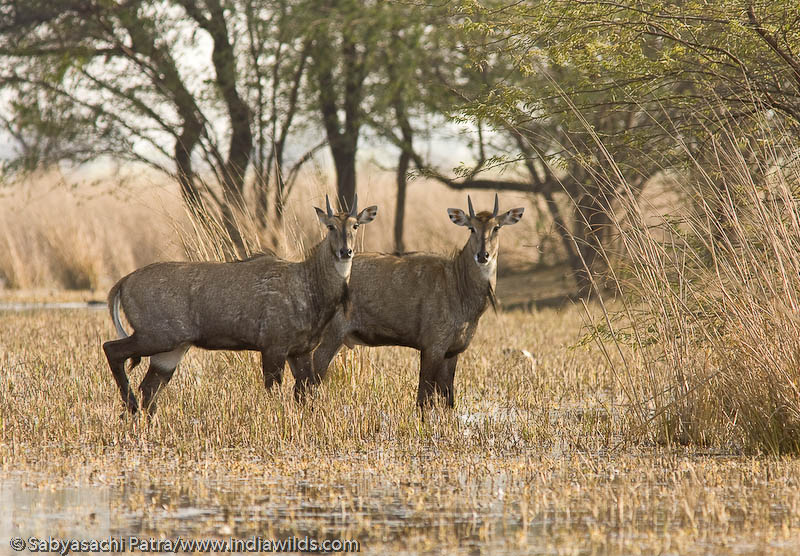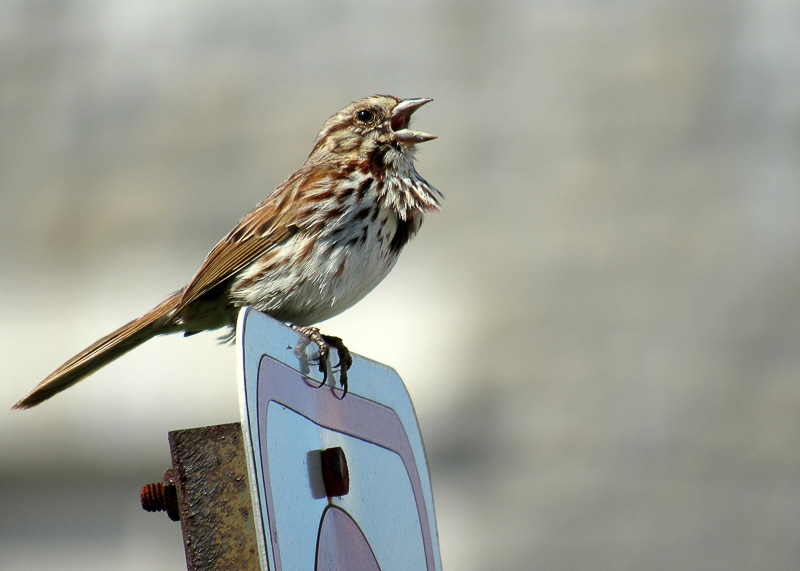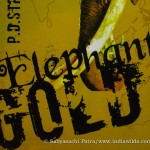IndiaWilds Newsletter Vol. 8 Issue VII
Inspiration from Wildlife – Butcher’s advice
When I walked into a shop my ears picked up discussion about wildlife. I moved in close to hear a shopkeeper telling his assistant “Don’t get angry. If you get angry then you can’t achieve anything. When a tiger is angry and wants to hunt deer then because of its anger it starts breathing faster. The deer hears the heavy breathing and runs away. Unlike the tiger the leopard doesn’t get angry. It moves silently towards its prey and when it is close to the deer it even stops breathing not wanting to make sound. So it is successful in hunting”.

A angry male wild tiger partly hidden in grass snarls at the tourists blocking its path. It is the dominant male of the Rajbehera area in Bandhavgarh National Park, India
While much of what he was saying is factually incorrect, it was delivered in a confident tone and a few other customers too were listening to this discussion. This conversation stands out amidst all the chatter of the Bollywood heroine’s baby bump and how cute the son of an aged superstar is etc.
If one takes a guess about the religion of this person, in these times of religious polarisation, most likely people may say that he may be a hindu. After all one can see many animals as the vehicle of the Gods and Goddesses adorning the calendars and photos in the walls in many shops. It may also be because a majority of Indians belong to this religion.
However, this person was a butcher selling chicken and meat and is a practicing muslim. Though a vocal part of the ruling party at the Centre wants us to believe that only people belonging to a particular religion are the custodians’ of India’s culture, it is not the case. The ruling party at the Centre, which talks about preserving India’s culture and heritage, has unleashed India’s biggest war on wildlife and has ordered killing hundreds of wild nilgais, boars, monkeys, peacocks and even as per some reports ordered killing of elephants. There lies the dichotomy. People who are supposed to have interests in wildlife are not always the one who champion the cause of wildlife.
There are wildlife resorts tom-tomming themselves as an ecotourism ventures, and start by cutting off all bushes and pruning trees so that there are no snakes, frogs and insects. In sharp contrast to these people there are communities who have lived in peace with wild carnivores as they know how to avoid them. In the night, most of the maldharis and shepherds lock up their livestock and retire for the night. So there is no conflict.
When I travel across India to film wildlife and encounter conflicts, too often I find that there is a huge level of fear for wildlife in certain sections of people. And this fear for wildlife is harboured by people who had never stayed close to wilderness areas. Most of these people are either displaced and have settled in areas close to wilderness where they encounter wildlife. The sight of a leopard makes them nervous. They immediately think that their life is in danger and start chasing the poor animal. People who have become affluent have now bought farm lands to cater to the craze of owning a farm house as it is increasingly seen as a status symbol. The moment these people sight an animal in their farm, they are driven by fear and start killing the animal.
There are researchers and naturalists who are supposed to love their subjects and stand up to protect them. Unfortunately, there are a few modern day researchers and decision makers who are quick to bow to the wishes of a vocal minority who often have vested interests in eliminating wildlife and trees from areas so that the landuse can be changed or areas can be denotified for industry and other projects.
In this modern India, struggling with such a dichotomy, there is still some hope for the wildlife. Even though India is increasingly torn asunder by religious fanatics, there is indeed an underlying awe in which people of various religious groups and atheists view wildlife.
The butcher’s exhortation to his subordinate to not become angry by giving an example of wildlife, albeit factually incorrect, tells us how wildlife is integrated in the psyche of Indians of all religions. With the explosion of human population, we have increasingly become alienated from wilderness. However, there is still a corner in our heart, which perhaps has a place and a soft corner for wildlife, which seeks inspiration from wildlife.
The intolerance for wildlife is there in many of our elites and in upscale localities. In the heart of Delhi a Nilgai (Boselaphus tragocamelus) was found roaming around the gardens near the Parliament. Immediately the security went on high alert and chased the Nilgai which panicked and started running helter-skelter. In the confusion it even banged on a police car. After two hours the forest department tranquilised and captured it. Come to think about it. A herbivore which roams around to feed itself without causing harm to people is chased and captured. Nilgai is not an elephant which can intimidate people. But such is the level of ignorance that the nilgai couldn’t be left alone to wander around in the parks. When there are hundreds of cows roaming around the streets, why capture a nilgai?

A pair of Nilgai or blue bulls (Boselaphus tragocamelus), India’s largest antelope, alert and ready to run through the marsh in Sultanpur Bird Sanctuary, India
Historically, there were lot of wildlife in the forests around delhi. These days after all the forests have been decimated and even the delhi ridge forest cutoff and encroached upon, the number of sambars and nilgais have gone down drastically. Even jackals are rarely seen these days. So when a butcher in New Delhi starts giving example of wildlife to calm down his assistant, I think it is an extremely positive sign and it is time for us to sensitise people about wildlife and help them take inspiration from nature and wildlife. Hopefully this can make Delhi and other big cities a less violent place.
The stress of living in urban areas with its intense competition for resources perhaps makes people become increasingly violent. In a 2011 study Psychiatrist Andreas Meyer-Lindenberg of Central Institute of Mental Health, Mannheim found that brains of people living in bigger cities don’t handle stress as well as rural folks (City living and urban upbringing affect neural social stress processing in humans, Lederbogen*, Kirsch*, Haddad* et al., Nature 2011). In the study, Meyer-Lindenberg and his group used functional magnetic resonance imaging (fMRI) to examine the Perigenual anterior cingulate cortex (pACC) and amygdala regions of the brain. They found that in people living in big cities, the amygdala of the brain – which is known to be involved in assessing the threat perception and generating fear and emotional reactions– was much more active than that of people living in rural areas. Current city living was associated with increased amygdala activity.

The researchers reported, “urban upbringing affected the perigenual anterior cingulate cortex, a key region for regulation of amygdala activity, negative affect and stress. These findings were regionally and behaviourally specific, as no other brain structures were affected and no urbanicity effect was seen during control experiments invoking cognitive processing without stress. Our results identify distinct neural mechanisms for an established environmental risk factor, link the urban environment for the first time to social stress processing, suggest that brain regions differ in vulnerability to this risk factor across the lifespan, and indicate that experimental interrogation of epidemiological associations is a promising strategy in social neuroscience”.
The increased level of violent behaviour is often seen in the abusive language people use at each other. It is becoming uniformly true both in cities in India where politicians across the political spectrum have been making unparliamentary language at their rivals as well as in UK (Boris Johnson), USA (Donald Trump, Ben Carson and many other Republican party officials). Though this has become a global phenomena, it would be prudent to use the advice of the butcher to learn from wild animals to remain calm. Schools, colleges and corporates should increasingly take the help of experts to talk about wildlife and learn from their behaviours. If we can create more wilderness areas in our parks, allowing trees and shrubs growing wild to harbour minor wildlife, then the urban denizens can still have a feeling of wilderness and calm. When we start respecting wildlife, we start loving them. When we love them, we start care about their wellbeing. Hopefully we can save our wildlife and wilderness areas for posterity.
Learnings from Wild Animals
As a filmmaker and photographer, I observe the wild animals for a long time often waiting to capture some unique behaviour. Spending time with them also leads me into analysing them. Many of my subjects, both non-human as well as humans leave some lasting impressions in me. There are many character traits of these wild animals which I find is worth emulating.
Click on the below link to read more:
Conservation News
Angry Birds
It is not only humans who are impacted by the stress of living in cities. A recent study titled “Agonistic urban birds: elevated territorial aggression of urban song sparrows is individually consistent within a breeding period” (Scott Davies, Kendra B. Sewall, Biology Letters, June 2016) found that even birds living in cities may appear to be angrier than their counterparts in rural areas as the urban birds display much higher level of aggression to defend their territories.
It is also true that birds raise their voice to be heard above the high ambient noise in urban areas. So if you wonder whether the bird singing near your window is slightly less melodious than the one you heard in the forest during your vacation, then you are not imagining things. We are indeed impacting the world around us in a negative manner.

Sparrow
When our population increases to 9.6 billion in 2050, which would be twice the carrying capacity of Mother Earth, there would be far less space for our wild birds who would have to struggle more to eke out a living in these urban spaces. And their voices would be harsher than what we are used to.
Environment Minister says no policy in the offing to stop elephant deaths by trains
The new minister for MoEF&CC Shri Anil Madhav Dave while replying to a question in Rajya Sabha, the upper house in the Parliament said that there is no policy at present under consideration to stop elephant deaths from speeding trains and electrocution. The minister said that Elephant is included under Schedule I of the Wildlife Protection Act, 1972, to provide it highest degree of legal protection and Twenty nine Elephant Reserves have been notified in 14 States for conservation of elephants.
In India according to the WPA, any vehicle involved in accident killing wild animals protected by law are impounded. However, trains belonging to the Indian Railways and owned by the Government of India, continues to repeatedly kill elephants throughout India and no action whatsoever has been taken against Indian Railways.

Elephant dragged 400 meters to the middle of a bridge
He said that general advisory was issued jointly to all the railway zones and relevant States Governments suggesting measures to prevent collision of trains with wild elephants. He claimed that the advisory given to the concerned agencies have resulted in significant reduction in the number of elephant deaths due to speeding trains and electrocution. However, the minister failed to provide any supporting data.
The advisory to the railway zones and state governments has these recommendations:
- Clearance of vegetation on the sides of railway tracks.
- Underpasses/overpasses/girder bridges across vulnerable stretches of railway tracks to allow safe passage elephants.
- Signage boards at selected points to alert train drivers.
- Sensitization programmes for Train Drivers/Guards/Station Masters.
- Engagement of elephant trackers and communication with Station Masters.
- To keep Railway tracks free from food wastes, that attracts elephants.
The minister further stated that a permanent coordination committee has been constituted jointly by the Ministry of Railways and the Ministry of Environment and Forests to share information and monitor the implementation of the advisory. In order to develop specific strategies and Standard Operating Procedures and for better coordination committees have been constituted between Zonal Railway Offices and State Forest Departments. Ministry of Railways has also been requested to regulate the speed of trains in identified vulnerable sections between sunset and sunrise. Chief Wildlife Wardens has been requested to take up the issue with electricity departments to prevent sagging of electric transmission lines and maintenance to minimum ground clearance as per rules.
Financial and technical assistance is provided to elephant range states under the Centrally Sponsored Scheme ‘Project Elephant’ for conservation and management of elephants. Improvement of elephant habitat, including Elephant Reserves and Corridors is carried out regularly.
Countries Reiterate Commitment to move away from High Global Warming Potential HFCs
India Highlights Importance of Having Verifiable Data on HFCs
Countries across the developing and developed world have reiterated their commitment to move away from high Global Warming Potential (GWP) HFCs to limit the increase in global temperatures while discussing the 38th meeting of the Open Ended Working Group of Parties to the Montreal Protocol currently underway in Vienna. The key issue being discussed is the baseline for non-Article 5 and Article 5 parties. Parties have highlighted that absence of verifiable historical data is a challenge in establishing a baseline for Article 5 and Non-Article- 5 countries.
The Indian delegation highlighted the importance of having verifiable data on HFCs to calculate the baseline and deciding upon baseline years. As such having baseline in the past without objective verifiable data is not logical, in the absence of which, it will be difficult to deal with future and work with uncertainties.
In addition, India has also submitted a Conference Room Paper (CRP) aimed at improving the transparency and flexibility of the Multilateral Fund of the Montreal Protocol (MLF). MLF has been the key in supporting the earlier transition away from Ozone Depleting Substances, and is widely recognised for its success as the only global scale financial transfer mechanism for mitigating environmental impacts. However, based on earlier experience of developing countries, there have been concerns around the flexibility and transparency of this extremely important mechanism. The Indian submission emphasises: (i) developing guidelines for incorporating the principle of flexibility, (ii) improving understanding of methodologies for calculating incremental cost, (iii) developing cost guidance for enhancing energy efficiency, (iv) increasing institutional strengthening for supporting any new commitments, and (v) prioritising technical assistance for building capacity to address safety issues.
Actual data on production and consumption of HFCs is necessary for understanding the historical evolution and establishing a baseline. The baseline is instrumental in determining future consumption and emissions. Many non-Article 5 parties like Canada, Norway, Japan, the EU, etc. have submitted that they have got reliable data for historical HFC consumption. Such data is not in public domain, besides data for most Article 5 parties (developing countries) is not available at all. Some of the Article 5 parties raised strong concerns that many countries in this grouping do not have an accounting system and inventory of HFCs in place.
Plaster of Paris idols banned in Chattisgarh
Chhattisgarh environment board realising the impact of idols made of plaster of paris and synthetic paints on the rivers and ponds has decided to that idols henceforth have to be made of natural soil and paint. The circular issued by the Chattishgarh environment board has been sent to all the district collectors of Chattishgarh, municipal authorities and to the police SPs. The size of the idols have also been fixed to a maximum of five feet. Apart from PoP baked clay will also not be allowed to be used in making idols.
The guidelines have also suggested that non-biodegradable materials be seggregated before immersion. The local authorities have to be also informed before any immersion of idols.
Plaster of Paris idols ban in Karnataka
Anyone immersing plaster of paris idols in tanks and lakes of Karnataka will be fined Rs. 10000/- and jailed says Karnataka State Pollution Control Board. Despite awareness campaigns people continued to immerse idols made of PoP and containing harmful synthetic chemicals that often resulted in polluting the waters and killing the fishes and other aquatic fauna, so finally the ban has been introduced. The tests by KSPCB revealed the high levels of pollution.
Procuring Idols from other states will be checked at the border check posts and all implementing authorities have been informed by the pollution control board. The sellers of such idols are liable to be prosecuted. How smoothly this order is going to be implemented is yet to be seen.
Karnataka bans chinese manja –
The Karnataka Government has banned chinese manja – the string made of nylon and/or other synthetic materials with glass coatings. These threads result in severe injuries to birds. Every year scores of birds get entangled in these threads and their wings as well as body gets severely lacerated. Many of them die or are permanently disabled. It is not just birds, but even people riding motor cycles have got deep neck injuries and have died due to these chinese manja. In most of the towns in Gujarat most of the motorcycles have an arched steel rod infront acting like a virtual shield for these chinese manja.
People use the chinese manja as they try to cut each other’s kite strings. What started as a part of fun and festivities have become enormously dangerous for birds and people.
The Department of Forest, Ecology and Environment of Government of Karnataka has issued the notification on June 24 and necessary action will be taken against violators as per WPA 1972, Karnataka Forest Act, 1963. This is a welcome move and needs to be strictly implemented.
239 rhinos poached in 16 years
The Assam forest department has revealed that 239 rhinos have been killed by poachers in the last sixteen years. This information was revealed by Pramila Rani Brahma, forest minister of Assam, in response to a question in the assembly asked by Ajanta Neog, an MLA belonging to the Congress party.
The figure of 239 rhino poaching cases dates back from the year 2001 to July 2016. It amounts to virtually 15 rhino’s per year. The forest minister blamed the lack of modern equipment to fight poachers. She said that the forest guards use ancient .303 rifles whereas the poachers use versions of AK 47 and was quoted as saying “We need to modernize equipment, to give uniforms, shoes to frontline forest staff”. It is really sad state of affairs that apart from equipment, the frontline forest staff who have to do routine patrolling duty don’t even have shoes and uniform. It is quiet natural that the morale of the staff would be abysmal.
The forest minister said that Assam forest department will probe the rhino killing incidents by transferring all the rhino poaching cases to the National Investigation Agency. The minister said that, 661 poachers who involved in rhino killing incidents were apprehended during the period. On the surface the handling of the probe to NIA may show some seriousness of the state government. However, one should also take it with a pinch of salt, as Assam has just got a change in Government from Congress to BJP after 15 years. In such situation one expects political witchhunting to be a part of this. We hope to be wrong.
We would be happy if every poaching of all charismatic species/mega fauna is handed over to the NIA (National Investigating Agency).
Green Train Corridor:
The Union Railway Minister Mr. Suresh Prabhu on Sunday inaugurated India’s first ‘Green Train Corridor’ between Rameshwaram and Manamadurai. In this 114-km long section, ten passenger trains with 286 coaches have been fitted with bio-toilets. Indian Railways have been using toilets which dump the human excreta on the tracks. It not only corrodes the tracks but also results in contaminating the ground water level as well as fresh water resources and spreading E. coli bacteria and other diseases. The fecal matter is also foraged by wild pigs, mongoose, birds etc and even antibiotic resistance passes to their bodies and from them to the food chain of wild animals. So stopping this open disposal of fecal matter through the toilets of Indian Railways will be a very good move
The Indian Railways have tied up with DRDO to develop environment friendly bio-toilets. The discharge from these bio-toilets are broken down by anerobic bacteria into water and gasses. The water is chlorinated and discharged onto the tracks.
According to the ministry, the Indian Railways have already installed 40,750 bio-toilets in all its coaches and it will completely shift to bio-toilets two years ahead of schedule by September 2019.
Book Review
Walking the Western Ghats By Dr. A.J.T. Johnsingh
The foreword to the book “Walking the Western Ghats” by Dr. A.J.T. Johnsingh has been written by John Seidensticker. To the laymen who have not heard of Dr. Johnsingh and who would like to know about this book, Dr. John Seidensticker has nicely summarised it in his foreword by writing “After a distinguished career at the Wildlife Institute of India, the renowned Indian conservation biologist Dr. A.J.T. Johnsingh returned to his home in the south to begin his second act. That included looking for the wild places, wildlife, and grand vistas in the Western Ghats by jeep and on foot because Dr Johnsingh lives to walk. This book is the chronicle of his quest as he travelled north and south in the Ghats seeking to identify where forest connections and other conservation interventions can be implemented to increase ecological resiliency in these mountains”.
To read more click the below link:
IndiaWilds App for Android Mobile
In India most of the internet penetration is happening through mobile phones. And the existing users who have access to desktops and laptops are becoming much more mobile then they used to be a few years ago. So to raise awareness and reach out to more people we need to adapt ourselves and make IndiaWilds easily accessed through a mobile phone using android OS.
We have created a mobile phone app so that people can access IndiaWilds anytime, anywhere without being tied to a computer. No need to type. One can access at the click of a button.
We have developed this app through Business Compass LLC a company based in Randolph, New Jersey, United States so that we create a good app.
Awareness is the first step before a person can become a champion of wildlife. I hope this will help us in reaching out to more people to raise awareness and make a real impact on the conservation landscape. If you have an android device then please download the app from this link:
https://play.google.com/store/apps/details?id=com.businesscompassllc.indiawilds
Equipment Discussions
Canon EOS 80D Review
Canon had announced the EOS 80D in the month of February 2016. Since April this camera is available in the market. Following is the hands-on-experience with this camera.

Canon EOS 80D Review
The Canon EOS 80D is a successor to the Canon EOS 70D. Whereas the Canon EOS 70D had 20.2 megapixels, the EOS 80D has 24.2 Megapixel APS-C sized sensor.
The form factor remains similar to the previous EOS 70D.
The size and weight is less and hence if you are in a trek then this camera slung around your neck is going to hurt less than the professional 1DX II.
To read more click on the below link:
Natural History
COUNTRY NOTEBOOK: M. Krishnan: ‘The Laughing Hyena‘ By Saktipada Panigrahi
http://www.indiawilds.com/forums/showthread.php?8852-Country-notebook-m-krishnan&p=80587#post80587
Stretching the wings by Samrat Sarkar
http://www.indiawilds.com/forums/showthread.php?17645-Stretching-the-wings&p=80647#post80647
Wildlife Photography
Chinkara from Mayureswar Wildlife Sanctuary by Subhash Shrivastava
Young Tusker in Corbett by Debasis Bose
http://www.indiawilds.com/forums/showthread.php?17606-Secrets-of-Rogue-Teenage-Tusker
Indian Golden Jackal by Sandipan Ghosh
http://www.indiawilds.com/forums/showthread.php?17566-Indian-Golden-Jackal
Bijlee Tigress in Ranathambore by Ashok Sorout
http://www.indiawilds.com/forums/showthread.php?17604-Bijlee-tigress-Ranthambore
Golden Langur by Samrat Sarkar
http://www.indiawilds.com/forums/showthread.php?17599-Golden-Langur_Outskirts-of-Manas-National-Park
Irrawaddy Dolphin at Sundarbans by Suman Bhattacharjee
http://www.indiawilds.com/forums/showthread.php?17581-Irrawaddy-dolphin-at-Sundarbans
Grey Headed Fish Eagle by Shyamala Kumar
http://www.indiawilds.com/forums/showthread.php?17545-Grey-Headed-Fish-Eagle-feeding-on-Fish
Rufous Necked Hornbill by Subhajit Chaudhuri
http://www.indiawilds.com/forums/showthread.php?17540-Rufous-Necked-Hornbill
Indian Chameleon by Prajwal Ullal
http://www.indiawilds.com/forums/showthread.php?17555-Mud-mud-ke-na-dekh
Parasitism by Surajit Bhadra Roy
http://www.indiawilds.com/forums/showthread.php?17541-parasitism
Red Pumpkin Beetle by Arun Acharjee
http://www.indiawilds.com/forums/showthread.php?17559-The-Leaf-Eater-2
I look forward to your inputs and support in preserving the last tracts of wilderness and wildlife left in our beautiful country. For other interesting articles and images check –http://www.indi
To post in the IndiaWilds forums, you can register free of cost using your Full Name as user id at
http://www.indiawilds.com/forums/register.php
If you are already a member of IndiaWilds and have forgotten your user id and/or password you can mail to
administrator@indiawilds.com
If you want to contribute original articles, or for any image enquiries please send a mail to
administrator@indiawilds.com
Regards,
Sabyasachi Patra
Profile | Contact Us | Facebook | Diary | Equipment reviews | Forums | IndiaWilds You Tube Channel
Please post your views and feedback in the comments below.
- GoPro Hero 12 Black - 6 September,2023
- Leopards: The Last Stand - 2 July,2023
- Drifting in the Waters of Sundarbans - 26 March,2023











Leave a Reply